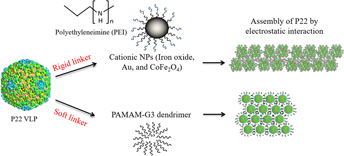Crossref Citations
This article has been cited by the following publications. This list is generated based on data provided by
Crossref.
Petrescu, Dan Stefan
and
Blum, Amy Szuchmacher
2018.
Viral‐based nanomaterials for plasmonic and photonic materials and devices.
WIREs Nanomedicine and Nanobiotechnology,
Vol. 10,
Issue. 4,
Timmermans, Suzanne B.P.E.
and
van Hest, Jan C.M.
2018.
Self-assembled nanoreactors based on peptides and proteins.
Current Opinion in Colloid & Interface Science,
Vol. 35,
Issue. ,
p.
26.
Ahmad, Fiaz
Ashraf, Noreen
Ashraf, Tayyba
Zhou, Ren-Bin
and
Yin, Da-Chuan
2019.
Biological synthesis of metallic nanoparticles (MNPs) by plants and microbes: their cellular uptake, biocompatibility, and biomedical applications.
Applied Microbiology and Biotechnology,
Vol. 103,
Issue. 7,
p.
2913.
Brunk, Nicholas E.
Uchida, Masaki
Lee, Byeongdu
Fukuto, Masafumi
Yang, Lin
Douglas, Trevor
and
Jadhao, Vikram
2019.
Linker-Mediated Assembly of Virus-Like Particles into Ordered Arrays via Electrostatic Control.
ACS Applied Bio Materials,
Vol. 2,
Issue. 5,
p.
2192.
Wang, Li
Gong, Coucong
Yuan, Xinzhu
and
Wei, Gang
2019.
Controlling the Self-Assembly of Biomolecules into Functional Nanomaterials through Internal Interactions and External Stimulations: A Review.
Nanomaterials,
Vol. 9,
Issue. 2,
p.
285.
Palchoudhury, Soubantika
Arabshahi, Abdollah
Gharge, Uday
Albattah, Abdulaziz
George, Olivia
and
Foster, Yasmin
2019.
Integrated experimental and computational approach for nanoparticle flow analysis.
Physics Letters A,
Vol. 383,
Issue. 14,
p.
1615.
Al-mahamad, Lamia L.G.
2020.
Gold nanoparticles driven self-assembling hydrogel via Host–Guest system.
Journal of Molecular Structure,
Vol. 1200,
Issue. ,
p.
127063.
Edwardson, Thomas G. W.
Levasseur, Mikail D.
Tetter, Stephan
Steinauer, Angela
Hori, Mao
and
Hilvert, Donald
2022.
Protein Cages: From Fundamentals to Advanced Applications.
Chemical Reviews,
Vol. 122,
Issue. 9,
p.
9145.
Rajasekar, Mani
Sree Agash, Saravanan Geetha
and
Rajasekar, Kumarasan
2022.
Review of photoresponsive and glycoside dendrimers in biomaterials and sensors applications.
RSC Advances,
Vol. 12,
Issue. 54,
p.
35123.
Patil, Rohit
Dehari, Deepa
Chaudhuri, Aiswarya
Kumar, Dulla Naveen
Kumar, Dinesh
Singh, Sanjay
Nath, Gopal
and
Agrawal, Ashish Kumar
2023.
Recent advancements in nanotechnology-based bacteriophage delivery strategies against bacterial ocular infections.
Microbiological Research,
Vol. 273,
Issue. ,
p.
127413.
Lee, Shih-Kuang (Alex)
Tsai, Sun-Ting
and
Glotzer, Sharon C.
2024.
Classification of complex local environments in systems of particle shapes through shape symmetry-encoded data augmentation.
The Journal of Chemical Physics,
Vol. 160,
Issue. 15,
Teng, Jiang
Liu, Yuheng
Li, Pei
Liu, Tianqiang
and
Liu, Xiaoqiang
2025.
Recyclable ZIF-8 inserted boronic acid-modified bacterial nanocellulose microspheres for improved tetracyclines removal from hoggery wastewater.
International Journal of Biological Macromolecules,
Vol. 306,
Issue. ,
p.
140914.
